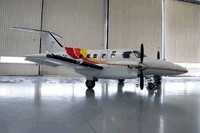
News
Embraer restrores prototype of the EMB 121 XINGU
 Sept. 8, 2009 – São José dos Campos, As part of the Company’s 40th
anniversary commemorations, Embraer performed a careful restoration of
the EMB 121 Xingu prototype, tail number PP-ZXI, which was the first
pressurized airplane built by the company
Sept. 8, 2009 – São José dos Campos, As part of the Company’s 40th
anniversary commemorations, Embraer performed a careful restoration of
the EMB 121 Xingu prototype, tail number PP-ZXI, which was the first
pressurized airplane built by the company
September 8, 2009 By Administrator
 |
|
|
|
Sept. 8, 2009 – São José dos Campos, As part of the Company’s 40th anniversary commemorations, Embraer performed a careful restoration of the EMB 121 Xingu prototype, tail number PP-ZXI, which was the first pressurized airplane built by the company. The restoration work was carried out by students from the National Industrial Apprenticeship Service (Serviço Nacional de Aprendizagem Industrial – SENAI) in São José dos Campos, Jacareí, and Taubaté, under the supervision of Embraer personnel. After being
displayed for Company employees, the aircraft will be on permanent exhibit at the Aerospace Museum (MUSAL), in Rio de Janeiro.
In 2009, the EMB 121 Xingu, of which 105 were built, celebrates the 30th anniversary of its certification. This initiative continues the process of restoring Embraer aircraft that began in 2008 with the second prototype of the Bandeirante. The airplane was originally designed and built by the then-Aeronautical Technical Center (Centro Técnico de Aeronáutica – CTA), now the Aerospace Technology General Command, leading to the founding of Embraer, on August 19, 1969. The same work was done on both prototypes of the CBA 123, in 2009.
“It has been a unique opportunity to be able to restore Embraer’s historic aircraft,” explains Pedro Ferraz, Director of the Embraer Education and Research Institute. “The Xingu PP-ZXI flew for the first time on October 22, 1976, and is different from the other models that were
manufactured. Following its validation, the cabin of this airplane was lengthened, in order to accommodate more passengers, and received more powerful engines. However, this version was never produced in series.”
Co-ordinated by technical leaders from Embraer, the students from SENAI dedicated themselves to the project simultaneously to their academic studies. The activities involved instruction, training, and oversight of the students who acquired knowledge regarding aircraft manufacturing, assembly techniques, and the use of specialized tools. During the restoration process, several parts of the fuselage, cabin, and wings needed to be rebuilt with composite materials.